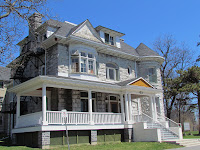
The sign on the fence below troubles me - it's like a 'do not resuscitate' sign on the chart of a dying patient. The fence encircles Kingston's former Rockwood Lunatic Asylum. True, it has had a tarnished past, as an institution for the criminally insane, then for people with psychiatric illnesses, and in its last iteration as an institution for individuals with developmental disabilities.
 Structures that housed former institutions are often abandoned and demolished. Ironic...Rockwood was an important public building in the c19; plans by William Cloverdale incorporated the newest and most humane approaches for "the insane". It was an "ideal asylum", a source of some pride.
Structures that housed former institutions are often abandoned and demolished. Ironic...Rockwood was an important public building in the c19; plans by William Cloverdale incorporated the newest and most humane approaches for "the insane". It was an "ideal asylum", a source of some pride.

The imposing limestone structure to the right, a masterpiece of classical symmetry and Renaissance motifs (its important dome, cupolas and roof towers were removed last century) is the main building on the park-like lakeside property. Today, folks with a great deal more freedom than Rockwood's original inhabitants walk or cycle the waterfront trail, sail the lake or wander the grounds beneath its walls.
The grand house to the left is called Leahurst. I wasn't able to find out much about it. It has a grand verandah and elegant doorway, dormers, bay window and a turret. Could have been offices or staff accommodation I suppose. Kingston readers may mock - "oh everybody knows that!".
Both the Asylum and Leahurst are vacant and boarded up. Are they dying or just dormant?
I wonder if as a society we don't just feel a bit awkward about former institutions and their histories, so that decision-makers in their never-ending quest for 'correctness' and fiscal responsibility delay decisions about adaptive reuse until it's too late, and doom to demolition otherwise beautiful structures. Certainly like all institutions, places like Rockwood were once thought of as "the best and only" way, the custodial solution to meeting extraordinary needs. Today we know better. Decades of deinstitutionalization (ref. Wolf Wolfensberger whose book Normalization provided guidance to my work in a former life, with folks with developmental disabilities) have brought awareness that institutional solutions often lead to abuses (via procedures, or efficiencies, not necessarily deliberate attempts to harm) that result in dehumanizing fellow humans.
Whoops, must take care not to trip over that soapbox while I'm putting it away.
The good news on the property is Rockwood House (the yellow house, above right). It's a great place, its style Palladian classicism, its date 1842, its architect George Browne. It was built as a country villa for lawyer and future member of legislative assemblies of Upper Canada and later Canada, John Solomon Cartwright. It was purchased by the government in 1856 to become part of the new asylum complex. Today Rockwood House sports a blue and gold Historic Sites plaque which identifies its style as "monumental Regency". Rockwood House is the home of some Ontario government offices.
So I'm keeping a cautious eye on the Rockwood Asylum. I have hopes for its future. In these ironic days, I think folks might appreciate the rightness of converting a former lunatic asylum into up market condos for the perennially stressed business elite , or into student housing or government offices. I must admit, I know not what wheels may currently be turning. Plans are afoot to convert an old government property on King Street closer to town into an arts centre, so maybe something good will come for Rockwood from this period of waiting. We have a fine building here, the product of style and workmanship that will never be achieved again.
Let's not let embarrassment about its past, and slow-as-treacle- government decision-making, result in Rockwood's being relegated to landfill.
Credit for the facts goes to Kingston's McKendry - Jennifer McKendry's fine book With our Past Before Us, on c.19 Kingston architecture (1995, UofT press) has a fascinating chapter called 'Controlling Society Through Architectural Design.
No comments:
Post a Comment